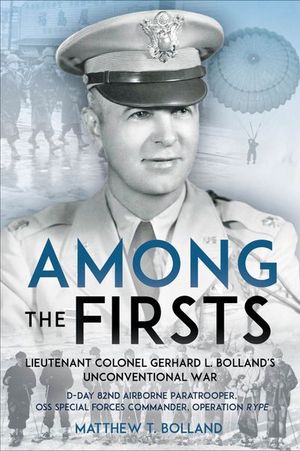Among the Firsts: Lieutenant Colonel Gerhard L. Bolland's Unconventional War
Published by Casemate Publishers
In his own words, the war of the doubly pioneering Lt Col Gerhard L. Bolland—82nd Airborne paratrooper on D-Day and senior OSS field operative on Operation Rype.
Unconventional warfare tactics can have a considerable effect on the outcome of any war. During World War II, the United States government developed and employed two new methods of fighting. The first was the development of "paratroop" units, as they were first called. The second was the formation of a covert and sabotage operations branch called the Office of Strategic Services (OSS). Lt. Colonel Bolland was involved in both of these "firsts." During the D-Day invasion he parachuted behind enemy lines, jumping out of the 82nd Airborne lead aircraft with General James Gavin. After fighting with the 507th Parachute Infantry Regiment for thirty-three days straight, he returned to England and became involved with the OSS Scandinavian Section. He served as Field Commander for their Operation, code named Rype. This was the only American military undertaking, albeit covert, in Norway during the entire course of the war. As a young boy growing up in rural western Minnesota, Bolland got his military start with the Minnesota National Guard, before being accepted to West Point, solely on merit. His military career lasted seventeen years. Lt. Colonel Bolland ended up with numerous decorations including the Norwegian Liberation Medal and Citation, the Bronze Star for valor, the French Fouragerre of Croix de Guerre with Palms and posthumously the Congressional Gold medal awarded to the OSS Society on behalf of all former OSS members that served during the war. His story reveals the struggles, successes, failures and ultimate victories, detailing what went right and what went wrong with these new unconventional methods of fighting.
Unconventional warfare tactics can have a considerable effect on the outcome of any war. During World War II, the United States government developed and employed two new methods of fighting. The first was the development of "paratroop" units, as they were first called. The second was the formation of a covert and sabotage operations branch called the Office of Strategic Services (OSS). Lt. Colonel Bolland was involved in both of these "firsts." During the D-Day invasion he parachuted behind enemy lines, jumping out of the 82nd Airborne lead aircraft with General James Gavin. After fighting with the 507th Parachute Infantry Regiment for thirty-three days straight, he returned to England and became involved with the OSS Scandinavian Section. He served as Field Commander for their Operation, code named Rype. This was the only American military undertaking, albeit covert, in Norway during the entire course of the war. As a young boy growing up in rural western Minnesota, Bolland got his military start with the Minnesota National Guard, before being accepted to West Point, solely on merit. His military career lasted seventeen years. Lt. Colonel Bolland ended up with numerous decorations including the Norwegian Liberation Medal and Citation, the Bronze Star for valor, the French Fouragerre of Croix de Guerre with Palms and posthumously the Congressional Gold medal awarded to the OSS Society on behalf of all former OSS members that served during the war. His story reveals the struggles, successes, failures and ultimate victories, detailing what went right and what went wrong with these new unconventional methods of fighting.
BUY NOW FROM
COMMUNITY REVIEWS

